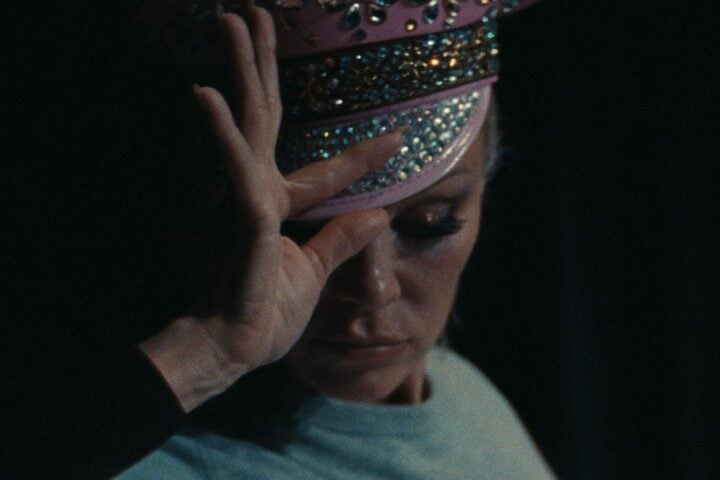Writer-director Tommaso Santambrogio’s Oceans Are the Real Continents follows three sets of characters living in the Cuban town of San Antonio de los Baños, located approximately 25 miles south of Havana. Puppeteer Edith (Edith Ibarra) and theater teacher Alex’s (Alexander Diego) marriage is troubled by Edith’s imminent departure for Italy. Fran (Frank Ernesto Lam) and Alain (Alain Alain Alfonso González), best friends on the cusp of puberty, dream of emigrating to play for the Yankees. Milagros (Milagros Llanes Martinez) is an elderly widow who, over the course of the film, rereads letters from a lover who never returned from Operación Carlota, Cuba’s mission in 1975 to support Angolan independence.
In a town set adrift in time, these representatives of three generations unknowingly orbit each other’s lives, united by a proclivity for imagination. Certain scenes in the film, which is shot in black-and-white and takes stylistic cues from the classics of postwar Italian cinema, are so cinematically self-reflexive (including a reference to Federico Fellini’s archetypically meta 8½) that they risk eliciting an eye roll. Instead, they’re likely to break your heart.
In one of the more elaborate and direct of these scenes, Alex and Edith wander tipsily into a movie theater—a “celluloid cemetery,” as Alex puts it. The screen is long gone and most of the seats have been torn out. Alex playfully invites Edith to watch a short film. He starts describing scenes from Nicolás Guillén Landrián’s 1965 short documentary “Ociel del Toa.” There’s much to be made of this reference to a filmmaker censored and then imprisoned for supposedly plotting to assassinate Fidel Castro, but given the themes of Santambrogio’s film, what’s crucial is the depiction of fictional characters reliving a documentary from memory.
“Cinema back then had fewer resources but was better,” Alex says. This isn’t—or at least isn’t merely—knee-jerk nostalgia but a disquieting gesture at the paradox that underlies every shot of Oceans Are the Real Continents. Santambrogio’s characters live in a country artificially deprived of resources and emptied by mass emigration, yet the imagination they exercise in remembering what they’ve lost, or in yearning for escape, lends a poetic richness to their lives. Maybe “Ociel del Toa,” too, is “better” for the fact that it can only be screened in the imagination. The self-reflexivity here is complicated by its absent referent, distilled in memory and imbued with longing, reflecting not merely itself but Alex and Edith’s personalities.
What makes this scene still more affecting is the way it rhymes with other scenes in the film. Take, for instance, when Fran and Alain sneak into a disused baseball stadium at night and imagine commentary on games once played there—games of their own invention. Or how Milagros makes two servings of food whenever she cooks, one for her and one for her absent husband, so that she can still share a meal with him. Because these separate stories reverberate with and comment on one another, they amount to more than the sum of their parts. Similarly, when the film incorporates other forms of artistic expression (including an extended puppetry sequence and a La Jetée-style photomontage), they arise organically from its characters and themes, resulting in more than a formal exercise in genre-blending.
It’s easy to romanticize destitution from a vantage point of material comfort, or another culture from outside of it, but Santambrogio transcends this with a real affection for his characters and the place they inhabit. While it’s true that he avoids a direct confrontation with the repression that Cubans face in addition to material hardship, he does make subtle nods, such as in the opening narration to Edith’s puppet play: “In a place amidst the oceans whose name I don’t care to remember, not long ago, a certain kind of music was forbidden because it aroused certain feelings.” Even censorship can become an opening for the imagination.
While Santambrogio can’t be accused of celebrating Castro-style communism, neither does he straightforwardly condemn it. What Oceans Are the Real Continents propagandizes, if anything, is the poetic impulse. Its title supposedly comes from a line of poetry, but it proved difficult for this critic to track down the poem. If Alex’s favorite poet is a fiction, that would be apt, as the film displays an almost disturbing reverence for the fictions—or delusions—that sustain us.
Made from the nostalgia and reflexivity that are contemporary storytelling ingredients, which should render it a faded copy of films that were groundbreaking in their day, Oceans Are the Real Continents still achieves a strange alchemy. Santambrogio puts neorealism in the service of dream. It’s not just another cinematic paean to the power of cinema, but to the imagination of which film is one manifestation—a paean to the paean in a more literal sense: poetic celebration.
Since 2001, we've brought you uncompromising, candid takes on the world of film, music, television, video games, theater, and more. Independently owned and operated publications like Slant have been hit hard in recent years, but we’re committed to keeping our content free and accessible—meaning no paywalls or fees.
If you like what we do, please consider subscribing to our Patreon or making a donation.


